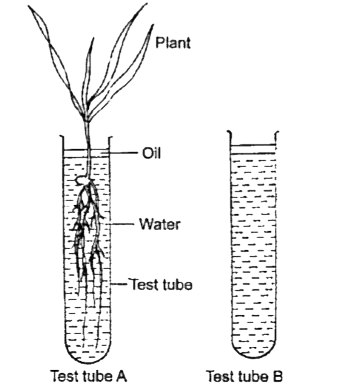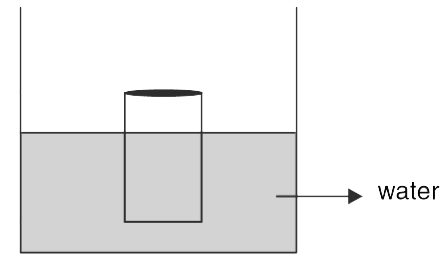Comment on the experimental setup.

(a) What does the setup demonstrate ?
(b) What will happen to the level of water if a blower is placed close to setup ?
(c) Will the mercury level fluctuate (go up / down) if phenyl mercuric acetate is sprayed on leaves ?
(a) The experiment giving explanation of theory of abscrbent force by transpiration.
(b) By supplying air continually rate of transpiration will increase level of water.
(c) Mercury will come down if phenyl mercuric acid sprinkled on leaf.
Topper's Solved these Questions
- TRANSPORT IN PLANTS BOOK - KUMAR PRAKASHANCHAPTER - TRANSPORT IN PLANTS EXERCISE - Questions from Module (Question Paper )
9 Videos
- TRANSPORT IN PLANTS BOOK - KUMAR PRAKASHANCHAPTER - TRANSPORT IN PLANTS EXERCISE - Section-E NCERT Exemplar (Short Answer)
24 Videos
- THE LIVING WORLDBOOK - KUMAR PRAKASHANCHAPTER - THE LIVING WORLDEXERCISE - OBJECTIVE SECTION (FILL IN BLANKS)
9 Videos
Similar Questions
Comment on the experimental setup :
What will happen to the level of water if a blower is placed close to setup ?
View SolutionStudy the set-up given alongside and answer the questions given below:

What will happen to the level of water in test tubes A & B?
View SolutionGiven below is an experimental setup to demonstrate a particular process in animals. Answer the questions that follow:

After a few hours what will happen to the lime water in Bottle A and in Bottle B? Give suitable reasons for your answer.
View SolutionA student focuses the image of a candle flame, placed at about 2 m from a convex lens of focal length 10 cm, on a screen. After that, he moves gradually the flame towards the lens and each time its image on the screen.
(a) In which direction does he move the lens to focus the flame on the screen?
(b) What happens to the size of the image of the flame formed on the screen ?
(c ) What difference is seen in the intensity (brightnees) of the image of the flame on the screen ?
(d) What is seen on the when the flame is very close (at about 5 cm) to the lens ?
View SolutionA student focuses the image of a candle flame, placed at about 2 m from a convex lens of focal length 10 cm, on a screen. After that, he moves gradually the flame towards the lens and each time its image on the screen.
(a) In which direction does he move the lens to focus the flame on the screen?
(b) What happens to the size of the image of the flame formed on the screen ?
(c ) What difference is seen in the intensity (brightnees) of the image of the flame on the screen ?
(d) What is seen on the when the flame is very close (at about 5 cm) to the lens ?
View SolutionA cyclindrical ice block is floating in water 10% of its total volume is outside water. Kerosene oil (relative density=0.8) is poured slowly on top of water in the container. Assume that the oil does not mix with water. Height of the ice cylinder is H.

(a) As kerosene is poured, how does the volume of ice block above the water level change?
(b) What is the thickness of kerosene layer above the water when 20% of the volume of the ice block is above the water surface?
(c) Find the ratio of voume of ice block is kerosene to its volume in water after the kerosene layer rises above the top surface of ice and the block gets completely submerged. Neglect any melting of ice.
View SolutionTo find the image-distance for varying object-distance in case of a convex lens, a student obtains on a screen a sharp image of a bright object placed very far from the lens. After that he gradually moves the object towards the lens and each time focuses its image of the screen.
(a) In which direction-towards or away from the lens, does he move the screen to focus the object?
(b) What happens to the size of image - does it increase or decrease ?
(c ) What happens when he moves the object very close to the lens ?
View SolutionTo find the image-distance for varying object-distance in case of a convex lens, a student obtains on a screen a sharp image of a bright object placed very far from the lens. After that he gradually moves the object towards the lens and each time focuses its image of the screen.
(a) In which direction-towards or away from the lens, does he move the screen to focus the object?
(b) What happens to the size of image - does it increase or decrease ?
(c ) What happens when he moves the object very close to the lens ?
View SolutionThe set up shown alongside was kept in sunlight for an hour. It was observed that drops of water appeared on the inside surface of the polythene bag
(a) Name the process which is being demonstrated.
(b) Why was the pot with its soil left uncovered by the polythene bag ?
(c ) Why was the pot left in sunlight?
(d) Suppose that the pot in this experimetn was placed inside a dark room instead of placeing it in sunlight for some time. What difference would be noticed?
……………………………….
View SolutionTo find the image-distance for varying object-distances in case o fa convex lens, a student obtains on a screen a sharp image of a bright object places very far from the lens. After that he gradually moves the object towards the lens and each time focuses its image on the screen.
(a) In which direction-towards or away from the lens, does he move the screen to focus the object ?
(b) What happens to the size of image - does it increase or decrease?
(c ) What happen when he moves the object very close to the lens ?
View Solution
